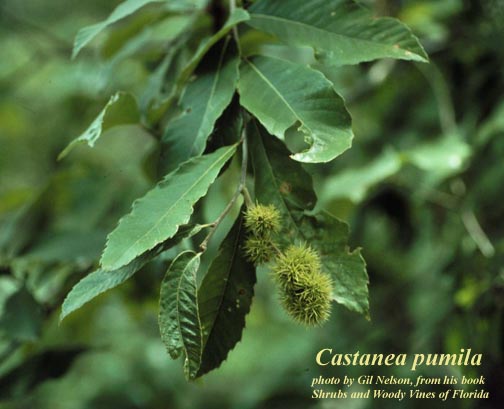Difference between revisions of "Castanea pumila"
| Line 32: | Line 32: | ||
==Ecology== | ==Ecology== | ||
===Habitat=== <!--Natural communities, human disturbed habitats, topography, hydrology, soils, light, fire regime requirements for removal of competition, etc.--> | ===Habitat=== <!--Natural communities, human disturbed habitats, topography, hydrology, soils, light, fire regime requirements for removal of competition, etc.--> | ||
| − | ''C. pumila'' is found in xeric forests and woodlands. <ref name= "Weakley 2015"> Weakley, A. S. (2015). Flora of the Southern and Mid-Atlantic States. Chapel Hill, NC, University of North Carolina Herbarium. </ref> It is also found along sand ridges. <ref name= "Johnson and Landers 1978"> Johnson, A. S. and J. L. Landers (1978). "Fruit production in slash pine plantations in Georgia." The Journal of Wildlife Management 42(3): 606-613. </ref> | + | ''C. pumila'' is found in xeric forests and woodlands. <ref name= "Weakley 2015"> Weakley, A. S. (2015). Flora of the Southern and Mid-Atlantic States. Chapel Hill, NC, University of North Carolina Herbarium. </ref> It is also found along sand ridges. <ref name= "Johnson and Landers 1978"> Johnson, A. S. and J. L. Landers (1978). "Fruit production in slash pine plantations in Georgia." The Journal of Wildlife Management 42(3): 606-613. </ref> Additionally, ''C. pumila'' is found in deciduous woods, old field areas, and sandy soil areas. <ref name = "FSU herbarium"> URL: http://herbarium.bio.fsu.edu. Last accessed: June 2018. Collectors: Loran C. Anderson, Robert K. Godfrey, Wayne R. Faircloth, A. F. Clewell, C. Jackson, H. Kurz, W. D. Reese, Wilson Baker, R. Kral, Robert W Simons, Richard S. Mitchell, Erdman West, Angus Gholson, George P. Johnson, Lucy B. Abbe, Ernst C. Abbe, Robert F. Martin, R. F. Thorne, R. A. Davidson, D.B. Ward, R.B. Smith, John K. Small, Ed Keppner, Lisa Keppner, Rodie White, R. Komarek, Andre F. Clewell, D. Demaree, Kathleen Craddock Burks, Travis MacClendon. States and counties: Leon County Florida, Calhoun County Florida, Santa Rosa County Florida, Wakulla County Florida, Suwannee County Florida, Hamilton County Florida, Walton County Florida, Okaloosa County Florida, Columbia County Florida, Jackson County Florida, Alachua County Florida, Duval County Florida, Escambia County Florida, Madison County Florida, Gilchrist County Florida, Bay County Florida, Liberty County Florida, Washington County Florida, Gadsden County Florida, Grady County Georgia, Thomas County Georgia, Decatur County Georgia, Carroll County Arkansas, Franklin County Florida, Autauga County Alabama. </ref> |
===Phenology=== <!--Timing off flowering, fruiting, seed dispersal, and environmental triggers. Cite PanFlora website if appropriate: http://www.gilnelson.com/PanFlora/ --> | ===Phenology=== <!--Timing off flowering, fruiting, seed dispersal, and environmental triggers. Cite PanFlora website if appropriate: http://www.gilnelson.com/PanFlora/ --> | ||
Revision as of 16:23, 22 June 2018
Common name: chinquapin [1], common chinquapin [2]
| Castanea pumila | |
|---|---|

| |
| Photo by the Atlas of Florida Plants Database | |
| Scientific classification | |
| Kingdom: | Plantae |
| Division: | Magnoliophyta - Flowering plants |
| Class: | Magnoliopsida - Dicots |
| Order: | Fagales |
| Family: | Fagaceae |
| Genus: | Castanea |
| Species: | C. pumila |
| Binomial name | |
| Castanea pumila (L) Mill. | |

| |
| Natural range of Castanea pumila from USDA NRCS Plants Database. | |
Contents
Taxonomic Notes
Synonyms: C. pumila var. ashei Sudworth; C. alnifolia Nuttall var. alnifolia; C. alnifolia var. floridana Sargent; C. ashei (Sudworth) Sudworth; C. floridana (Sargent) W.W. Ashe; C. alnifolia
Varieties: Castanea sativa P. Miller
Description
C. pumila is a perennial shrub/tree of the Fagaceae family native to North America. [1]
Distribution
C. pumila can be found along the southeastern coast of the United States, from Texas to Massachusetts. [1]
Ecology
Habitat
C. pumila is found in xeric forests and woodlands. [2] It is also found along sand ridges. [3] Additionally, C. pumila is found in deciduous woods, old field areas, and sandy soil areas. [4]
Phenology
C. pumila flowers March-June. [5]
Fire ecology
C. pumila is found mostly in fire-maintained habitats. [2] It is not fire resistant, but has a high fire tolerance. [1]
Use by animals
C. pumila is highly palatable to browsing animals and is edible by humans, but is not very palatable to grazing animals. [1]
Diseases and parasites
C. pumila is relatively resistant to chestnut blight. [2]
Conservation and Management
Cultivation and restoration
Photo Gallery
References and notes
- ↑ 1.0 1.1 1.2 1.3 1.4 USDA Plant Database https://plants.usda.gov/core/profile?symbol=CAPU9
- ↑ 2.0 2.1 2.2 2.3 Weakley, A. S. (2015). Flora of the Southern and Mid-Atlantic States. Chapel Hill, NC, University of North Carolina Herbarium.
- ↑ Johnson, A. S. and J. L. Landers (1978). "Fruit production in slash pine plantations in Georgia." The Journal of Wildlife Management 42(3): 606-613.
- ↑ URL: http://herbarium.bio.fsu.edu. Last accessed: June 2018. Collectors: Loran C. Anderson, Robert K. Godfrey, Wayne R. Faircloth, A. F. Clewell, C. Jackson, H. Kurz, W. D. Reese, Wilson Baker, R. Kral, Robert W Simons, Richard S. Mitchell, Erdman West, Angus Gholson, George P. Johnson, Lucy B. Abbe, Ernst C. Abbe, Robert F. Martin, R. F. Thorne, R. A. Davidson, D.B. Ward, R.B. Smith, John K. Small, Ed Keppner, Lisa Keppner, Rodie White, R. Komarek, Andre F. Clewell, D. Demaree, Kathleen Craddock Burks, Travis MacClendon. States and counties: Leon County Florida, Calhoun County Florida, Santa Rosa County Florida, Wakulla County Florida, Suwannee County Florida, Hamilton County Florida, Walton County Florida, Okaloosa County Florida, Columbia County Florida, Jackson County Florida, Alachua County Florida, Duval County Florida, Escambia County Florida, Madison County Florida, Gilchrist County Florida, Bay County Florida, Liberty County Florida, Washington County Florida, Gadsden County Florida, Grady County Georgia, Thomas County Georgia, Decatur County Georgia, Carroll County Arkansas, Franklin County Florida, Autauga County Alabama.
- ↑ PanFlora Author: Gil Nelson URL: http://www.gilnelson.com/PanFlora/ Date Accessed: 5/18/18